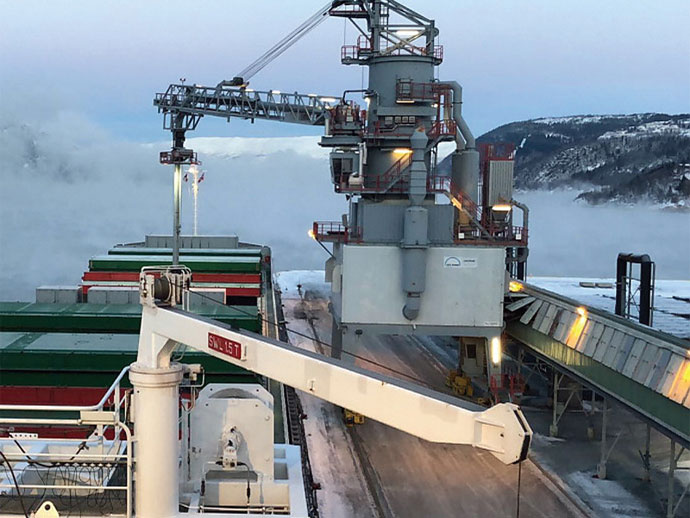Supply disruptions, labor actions, environmental policies and Russian sanctions combine to upend global alumina market
In the spotlight. A confluence of conditions involving supply disruptions, labor actions, Chinese environmental policies, and sanctions against a Russian businessman yielded a spike in the price of alumina so steep that it motivated Chinese producers to start exporting the commodity. Normally, aluminum producers in China can absorb all domestic alumina production and then some, as the country is historically a net importer of the commodity. But that situation has changed, at least for now.

In April, the spot price for alumina doubled to over $700 per ton, in reaction to the U.S. sanctions on Deripaska, and it climbed again by over 30 percent in the third quarter of 2018. Exacerbating the Deripaska situation was a production cut at the Alunorte alumina refinery in Brazil, after environmental regulators ordered the plant to produce at half capacity for contaminating local drinking water. For good measure, unions struck an Alcoa operation in Western Australia at the same time. Meanwhile, many U.S. manufacturers are reporting increased costs for inputs.
“The forced cutback in production in Brazil reduced supply by three-million tons, which is significant,” said Andrew Wood, an executive strategist at Alumina Limited, a Melbourne, Australia- based company that mines bauxite and refines alumina through a joint venture with Alcoa. “That was one development that underpinned the increase in aluminum and alumina prices.”
The price spike incentivized Chinese producers to start exporting to countries as diverse as Iceland, India, Russia, Malaysia and Cameroon. China’s alumina exports surged from less than 30,000 tons in August to over 165,000 tons in September, a 3,400 percent more than a year earlier.
The market has since calmed somewhat, as the Alcoa strike ended in late September and Hydro, the company that owns the Alunorte plant, paid $40 million in fines to the Brazilian government, the first step towards revving production back to normal levels. But the forward price for the commodity still sits at well over $500 dollars per ton, suggesting that the alumina market is not out of the woods just yet. And part of that is because of internal Chinese environmental policies.
Beijing and Alumina
Beijing’s war on smog embraces the entire aluminum production process in China, and includes cutbacks in alumina production volumes. The government’s latest three-year plan to reduce air pollution expands the targeted area subject to the regulations and extends it beyond last year’s November-to-March time frame. The bottom line is that around 70 percent of China’s alumina capacity is located in this year’s targeted areas, impacting those businesses to a much greater extent than last year. Meanwhile, the only alumina refinery currently under construction outside China is the Al Taweelah project in the United Arab Emirates.
The Chinese state-owned Aluminum Corp. of China (Chalco) warned in July that 770,000 tons of its annual alumina capacity would be subject to curtailments. Also in July, another producer, Luoyang Heungkong Wanji Aluminium, said it would be cutting its annual output by 680,000 tons. Five other major Chinese refineries have since followed suit.
In addition, five new coastal alumina refinery projects in Liaoning province were cancelled in August due to environmental protection regulations. While the Liaoning government is reconsidering these refinery projects, “If revived, the total capacity of the projects is likely to be less than their pre-cancellation targets,” said Wood. All this means that Chinese aluminum producers will have to tap international markets for more alumina just when supply is tight.
Other developments leave the future picture cloudy, supporting the likelihood that the price volatility of alumina will remain, at least in the short term. “Chalco is in the early stages of planning a new refinery in Linyi City,” said Wood, “which, if built, would process imported bauxite via Lanshan Port.” And the Wall Street Journal has reported that China COSCO Shipping is in the market for 25 new ore-shipping vessels intended for transporting bauxite from Guinea to China for use in Chalco smelters. That potential $1.5-billion vessel order would one of the largest ever in the dry bulk sector.
The acquisition would complement Chalco’s plan to invest $700 million in Guinea’s Boffa project—to include a new mine, new port facilities, and upgrades to the area infrastructure—which is expected to eventually provide the company with 12 million tons of bauxite annually through 2028. An initial order for seven ore vessels will likely be completed in the coming year, the WSJ reported, with the vessels coming online beginning in 2021.
Importing these new massive levels of bauxite would suggest that China is interested in expanding, or at least maintaining, its alumina production capacity, as it comes at a time when domestic bauxite mining is experiencing a shortfall due to the depletion of supply and the curtailment of production for environmental reasons. Time will tell whether the current level of high pricing will continue to encourage traders to export the commodity throughout the world or whether it will be used to produce aluminum domestically. It is clear, however, that government policy aims at making China self-sufficient in aluminum.
All this uncertainty supports a scenario for firmer alumina prices, at least for the next couple of years. “Some progress has been made in resolving the Alunorte and Rusal issues,” said Wood. “I expect resolution by mid-2019 but the timing is uncertain. Ongoing environmental and supply-side reforms are expected to slow Chinese growth and add costs. There may be some price volatility until supply issues are resolved and the market resettles.”




